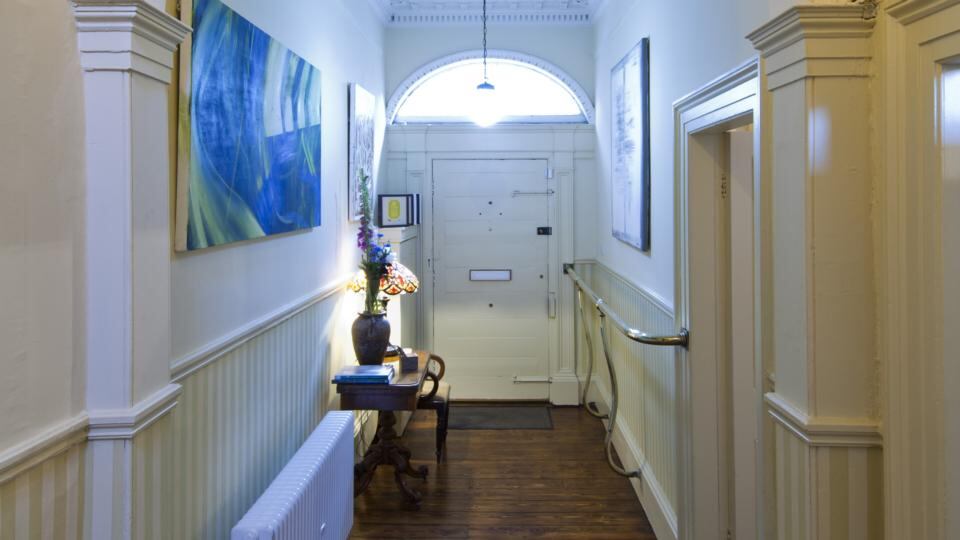When Kevin Desmond bought this Georgian house, on Synge Street, in Dublin 8, it was divided into nine pre-’63 bedsits. And although he has renovated five houses over the past 15 years, this was Desmond’s first listed building project.
The house dates from the 1830s and started life as a finishing school for girls with beautiful period features. But by the time Desmond got to it, each room in the house had a bathroom and kitchen and needed renovation. The 278sq m (3,000sq ft) property had never been plumbed for heating and had to be rewired. And the plasterwork, although for the most part looked like it was in good condition, had to come down, dry out and be put back together like a jigsaw puzzle.
“The ceiling rose, in what is now the master bedroom and was then a ballroom where the girls learned to dance, was unrecognisable, defaced by water damage and years of paint,” says Desmond. “That one room took six weeks to repair. Restoring plasterwork is slow and expensive.”
0 of 4
Desmond spent about a year trawling the salvage yards of the capital every Saturday in search of items for the house. All the floors, with the exception of one room in the basement, had to be treated for woodworm. He found replacements for missing boards and searched until he found the right match for the skirting.
“You have to put in the work yourself,” he says. “You can’t expect your builder to find it all.”
Desmond sourced 18 matching door handles at Architectural Salvage because he had given the staff there a list of his requirements. There was a lot of “pot luck” to finding stuff, he says.
All the shutters, window boxes and windows had to be repaired. They all remain single glaze. Cords, sashes and weights had to be replaced. Each of the house’s 18 windows took a carpenter two weeks to restore.
The roof had leaked and caused water damage on the first floor. Desmond’s builder had to restore and re-use the original tiles, but many broke or were damaged when they were removed, so he had to add roof slates to his salvage yard shopping list. The gutters and downpipes also had to be replaced.
He discovered a granite floor underneath the lino in the kitchen. The surround for the Aga is also granite, as is the fireplace in the bedroom at garden level, as well as the front steps, pillars and window sills.
Do not attempt such work without the expert help of a Grade 1 conservation architect, says Desmond. “You need someone you can trust, who will be able to give you realistic costs for the works.” He enlisted Mesh Architects, a Grade 1 conservation practice run by Thomas McGimsey.
Before you start, ascertain what kind of planning permission you require, says Desmond, advising that most planners are amenable to the conversion of properties with pre-’63 flats and bedsits into single-use homes.
Desmond started his planning application process three months before he got the keys to the house. He developed a good relationship with the agent, who lent him the keys to let in builders and other contractors so that they could ascertain what works needed to be done and advise on costs. He had planning permission before the deal had closed, so he didn’t waste a single day of mortgage repayments. It also helped expedite the work.
Having renovated four houses before using the same builder, Desmond had a professional in place whose work he respected and whom he could trust.
Raising the money for a restoration can be difficult, he says. “The banks won’t take the improvements into consideration in your mortgage application.”
During the restoration Desmond had 20 tradesmen working on site for a period of six to nine months. He estimates the final cost was somewhere between €250,000 and €300,000. This excludes the price of bathrooms and a kitchen.
He just celebrated his first anniversary in the house. “It’s a beautiful house with a great sense of space,” he says.
Each set of windows has shutters and heavy curtains keep out much of the cold. But with ceilings four to five metres high, it can be “a little cool”, even though he lights a fire most evenings.
The Aga in the kitchen is on around the clock and the warmth from it travels up through the house, warming each floor as the heat rises.
Since 2000, there’s been a rethink in the approach to period homes. Properties have been identified and listed, which gives the council more say, writes Noel O’Dwyer, partner at Node Architects
Windows and doors
The standard conservation mantra is "repair rather than replace". It is better to make good on the windows and doors in situ, and repair that part of the historical fabric of the building than replace.
Roof and external walls
The roof needs to be kept dry and probably insulated. It, along with the external walls, forms part of the external envelope of the house. The type of insulation will depend on the type of house. If you are repairing the roof the original tiles need to removed and, once works are completed, returned to the roof where possible. If the external walls are brick they may need to be repointed. If they are rendered or plastered there are different ways of dealing with that.
Insulation
The type of insulation you use will depend on the age of the building you’re living in. Nineteenth-century properties, for example, have a lot of internal detailing, cornicing, dado rails and so on, so it is not recommended that you dry -line them. You can stop the draughts, starting with insulating the roof, then invest in good windows and a good heating system, as well as cheap fixes such as balloons up fireplaces that you’re not using.
Flooring
Most flooring tends to be in reasonably good condition. Boards that need to be replaced can usually be found at salvage yards. You will need to take them up to lay down heating and electrical systems.
Internal joinery
Missing bits of internal joinery, panelling, skirting boards and architraves can be replaced. Cut a small piece to take with you to find a match when shopping at salvage yards.
Internal plasterwork
Damaged internal plasterwork can be replaced. There are several well-regarded companies specialising in this area and who understand how these things work. Historic Plasterwork and the Old Mould Company are two. Contemporary extensions A building should be of its time is the rule of thumb applied by most local authorities when it comes to planning. This gives some wriggle room when it comes to contemporary extensions to period homes, but be warned each application is dealt with on a case by case basis.
Resources
- The planning section of Dublin City Council's website has a good list of all the protected structures in the city, grant schemes and useful links; dublincity.ie.
- The Irish Georgian Society's Traditional Building Skills Register lists craftspeople and professionals with conservation expertise. It also provides advice on how to research your period house; igs.ie.
- The Royal Institute of Architects of Ireland is the regulatory and support body for architects in Ireland. Its online directory lets you search for accredited conservation architects; riai.ie.
- The Register of Heritage Contractors has a list of reliable heritage contractors; heritageregistration.ie.





















